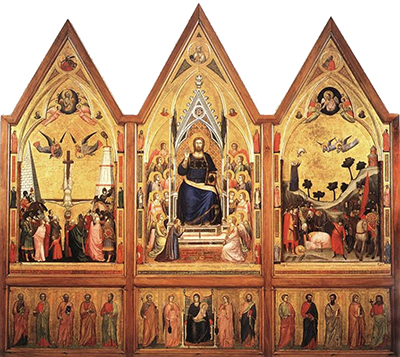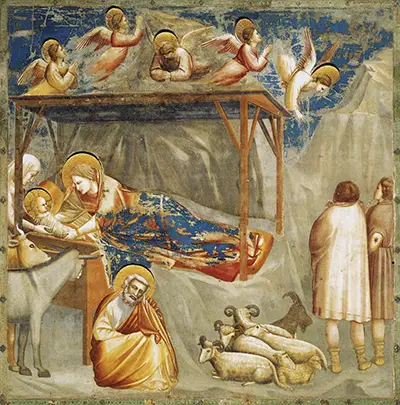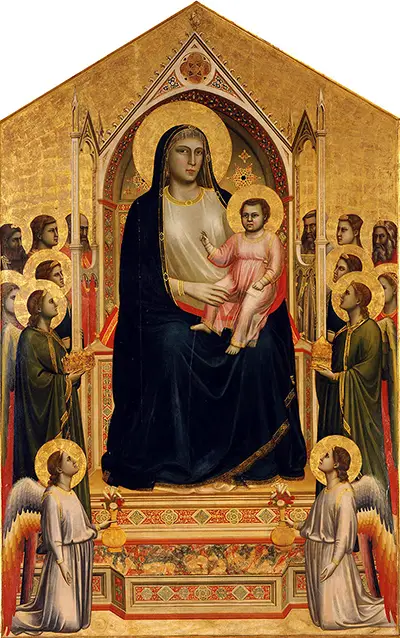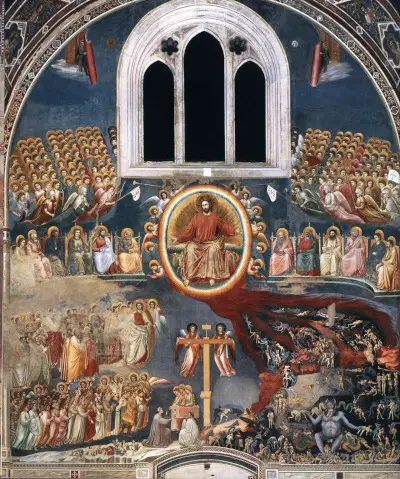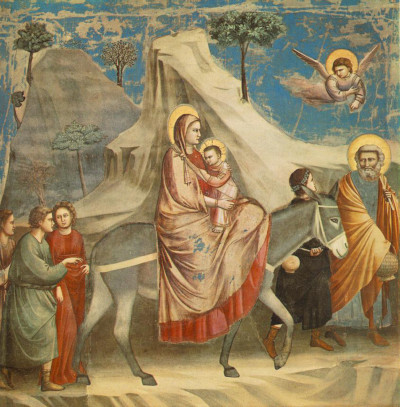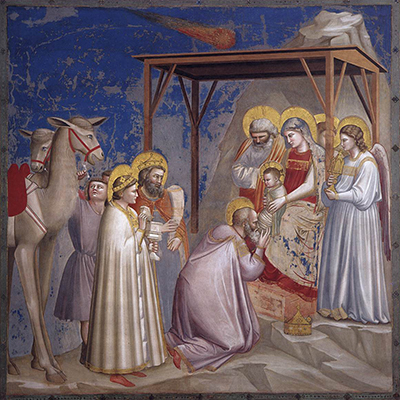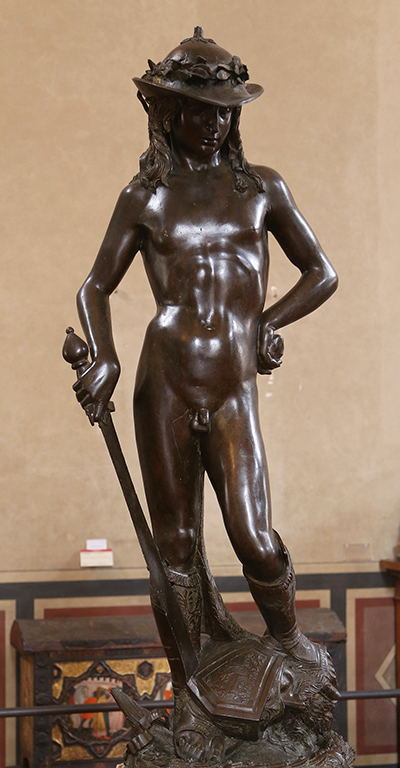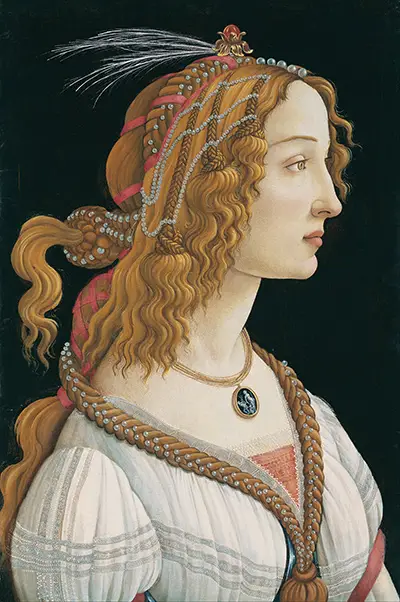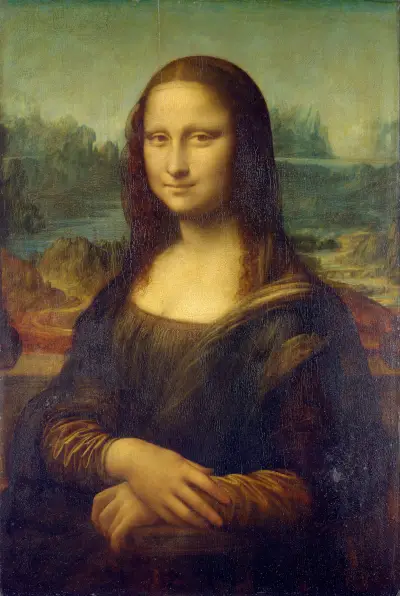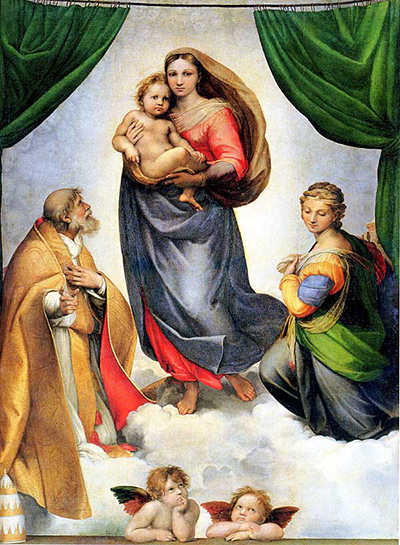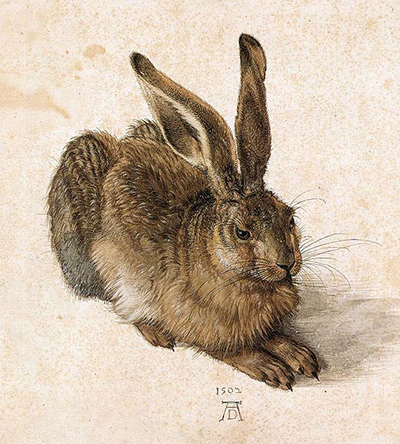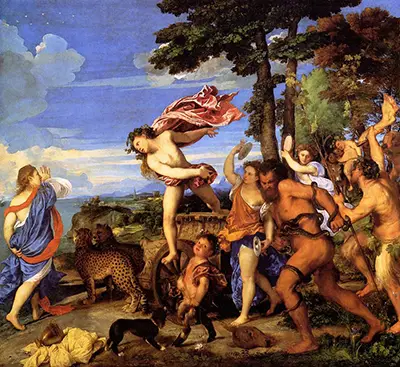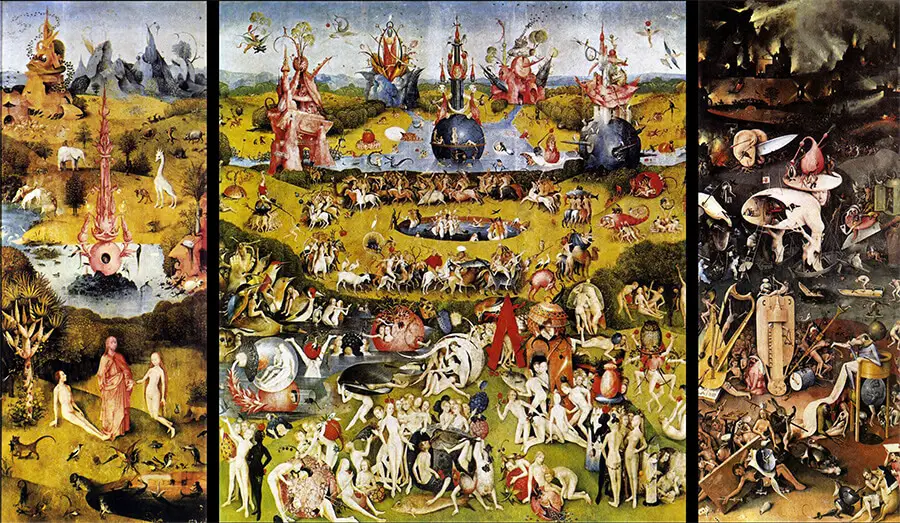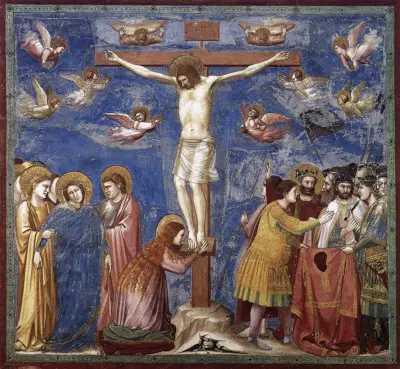 Buy Art Prints Now
Buy Art Prints Nowfrom Amazon
* As an Amazon Associate, and partner with Google Adsense and Ezoic, I earn from qualifying purchases.
The Crucifixion was a common theme within the workshop of Giotto, with this version being produced in around 1303 to 1305. Here we discuss this important artwork and also compare it with his other interpretations of this iconic Christian image.
This artwork can be found within the Scrovegni Chapel, alongside a whole host of other fresco paintings by Giotto di Bondone. The overall cycle remains his finest artistic achievement and continues to draw crowds to the chapel today. Padua, the city in which the chapel is located, has been designated an area of great cultural significance and the contributions of Giotto and his workshop played an important role in achieving that status. Most art historians will refer to the cycle as a whole, or perhaps pick out The Last Judgement for particular attention because of how it fills a single wall, but often the other items will not be discussed individually. Here we examine the Crucifixion fresco itself, placing it within the context of the overall project but also comparing it to Giotto's other interpretations of The Crucifixion. It is also necessary to discuss the meaning of the theme itself, and why it has featured so heavily within European art, particularly during the Italian Renaissance. Finally, we also look into how other artists have also tackled this topic over the past few centuries.
When planning this particular fresco, Giotto would design dozens of related artworks which would be installed together within the Scrovegni Chapel. He would have a single day to complete each section of the wall, before it dried. Paint would be applied as the plaster dried, though Giotto had a number of assistants who could help out with much of the work. He would allow them to paint the less significant parts of the compositions, freeing up his time to focus on the most important parts. He could also oversee the overall project to ensure that artworks such as The Crucifixion would follow a consistent pattern that ran across the whole cycle of frescoes. This huge body of work was delivered in just under two years thanks to the support that Giotto received and the display would become the highlight of his career. Christian themes continued to appear within his career for decades to come, including several more interpretations of The Crucifixion which themselves have since been dispersed right across the western world. His own contributions may well have influenced later artists in how they tackled the same subject.
The chapel itself was designed to provide a burial spot for its patron and his wife, and was built close to their own mansion in Padua, Italy. Therefore, it was important that the finest art would decorate this important religious venue, as the family would also worship here during their own lifetime. The impact made by the chapel would go far beyond the family itself, and it has helped the city of Padua to become regarded as a cultural centre. It continues today to receive thousands of visitors every year, though this small building was never designed with that in mind. Inevitably, the frescoes have deteriorated over the centuries, but efforts have been made to protect and restore them, allowing future generations to continue to enjoy the considerable achievements of Giotto and his workshop. The success of the designs was underlined with how some local religious groups looked at the chapel with envy, feeling that their own places of worship would be overshadowed by this incredible artistic feat. They attempted to penalise the patron, but were ultimately unsuccessful.
Table of Contents
- Description
- Meaning
- Style and Technique
- Location
- Size
- History of the Scrovegni Chapel
- Related Artworks within the Life of Christ Series
- Giotto's other Crucifixion Paintings
- Interpretations by other Artists
- Large Image of The Crucifixion
Description
Giotto's version of The Crucifixion in the Scrovegni Chapel features Christ in his familiar position of hanging limply from a wooden cross. He looks pale and skinny, with his rib cage visible and just a small cloth covering his modesty. A halo is added around his head to signify divinty and his arms looks particularly frail. His head hangs down whilst angels fly in the distance, with five on each side of the cross. The blue tone of sky continues all the way down to the rocky landscape in which his cross is positioned. We are therefore set outside of the city perimeter, though many have gathered close by to witness proceedings. The foreground is then separated into two, with mourners to the left and soldiers the right. A small garment is held up, showing what Christ was wearing prior to be lifted onto the cross. Halos are given to those on the left hand side, as they console each other over Christ's horrendous demise. Mary Magdalene, one of his followers, would kneel by his side, in desperate sadness. Many of the innovative elements found in this version would then continue into Giotto's later Crucifixion paintings, underlining how satisfied he must have been with this earlier version.
Meaning
The sacrifice made by Christ is believed to have been for the sake of eventual victory. Indeed, this sad moment was planned by God himself as part of the journey for Man. Art would then make use of the topic as a means to remind followers of this sacrifice and that one should respect and appreciate the role served by Christ. In order to dramatise the event, most compositions would separate the content into the role played by local soldiers who carried out this punishment, as well as the loyal followers of Christ who were heartbroken by events. This iconic image would also be used by sculptors too, dating back way before the time of Giotto and the Proto-Renaissance. Certain elements of the scene would also be repeated many times over, such as the figures included alongside Christ himself as well as the angels flying above. Colours schemes, however, have varied, with Giotto's version in the Scrovegni Chapel being amongst the brightest, with most shrouded in darkness in order to deliver a particularly sad and depressing mood to fit the content being delivered. The different versions by Giotto also help us to understand more about how he re-considered this theme over the course of his career.
Style and Technique
Giotto used a fairly natural style for his figures, right across this series of frescoes. There was no idealisation or elongation, just precise clothing, real facial features and forms that one could connect with in real life. He chose not to use golden paint for these artworks, but it was used regularly later on in his career. He also offered a strong use of blue tones which persisted throughout his chapel frescoes. Each section of the wall had a day of work before the plaster would be left to dry, with paint applied whilst it was soft and pliable. In order to keep the project on track, Giotto brought his workshop into the building and even hired additional artists who could implement his designs in a reliable manner. The frescoes themselves took nearly two years in total, and the building was finished around five years after the patron had originally purchased the land. Many artists have since visited the chapel in order to see how Giotto handled the various subjects found here, as well as his method of planning and delivering such a large project. Fresco art is something of a niche today, because of the difficulties that are involved with this discipline, but Giotto was a true master of the technique and was well supported by his experienced colleagues.
Location
The Crucifixion can be found on the lower tier of the chapel's north wall. The fresco is joined along this horizontal section by The Ascent to Calvary and the Lamentation of Christ, which sit either side of it, as well as The Resurrection of Jesus — Noli me tangere, Ascension and Pentecost. Even the lowest tier is above head height, meaning that visitors will have everything above them when entering the chapel. The Scrovegni Chapel itself is based in the Italian city of Padua, and the frescoes have remained here ever since they were first competed in the very early 14th century. The nature of this traditional art form makes it very hard to move them elsewhere safely and locals have also resisted any attempts to re-locate these important artworks from their original positions. The chapel itself is open to the public, with numbers limited in order to allow for the preservation of the building, as well as taking into consideration the small nature of this venue, with limited access points. The importance of the Crucifixion theme within Christian art makes it one of the most famous elements within this cycle of frescoes.
Size
The Crucifixion by Giotto from 1303-1305 was 200cm tall and 185cm wide. This includes the brown and green frames around the artwork. The artist kept this size consistently throughout his cycle of frescoes in the chapel which were devoted to the life of Christ. The same can be said for The Life of Mary as well, though there were some additional artworks which had to adapt to the intricate design of the chapel interior, which meant they needed to be custom designs. There was also the Vices and Virtues which were narrower and styled fairly differently, as well as The Last Judgement which filled an entire wall around the entrance to this room.
History of the Scrovegni Chapel
Enrico Scrovegni created an ambitious plan in which his family would have its own purpose-built mansion, with a chapel alongside. The Paduan banker set about purchasing the land in the very early 14th century before constructing the architecture. Giotto was then brought in, alongside a large team of assistants, to plan, design and build the internal decorations for the chapel. The family were intended to be buried here and so it was of particular importance to them. Between 1303 and around 1305 the frescoes were painted, including The Crucifixion, and the chapel was opened. Giotto himself designed the compositions and worked with his assistants to implement each design. More recently the building has been opened up to the public who visit in large numbers, all year round. Padua itself has been designated as a UNESCO destination of cultural value and several other important artworks can be found here. Visitors from abroad to the North of Italy will regularly be brought here as part of a longer trip that normally includes other cultural regions such as Venice.
Related Artworks within the Life of Christ Series
Either side of The Crucifixion you will find The Ascent to Calvary and the Lamentation of Christ. The north and south walls of the chapel are filled with several rows of artworks covering both the life of Mary and Christ. Giotto picked out some of the most iconic themes from the Bible which relate to those subjects, and he may also have been influenced by other historical art that he had seen elsewhere in Italy. Kiss of Judas is also one of the more well known frescoes from the series, with other highlights related to Christ's life including the likes of Nativity – Birth of Jesus, Last Supper and the Adoration of the Magi. There were twenty four artworks devoted to Christ within the cycle, as well as two corettos which were adapted scenes for curved sections of the chapel interior. Many of the subjects found within this cycle would re-appear later in his career, either in other series or sometimes as independent artworks. As mentioned, The Crucifixion would be one of the most reproduced topics in his career, with several different interpretations appearing over a number of decades.
Giotto's other Crucifixion Paintings
Giotto produced a number of depictions of The Crucifixion, dating from 1303-1305 to around 1325. All placed Christ on the cross, lifted above the other figures and in the centre of each composition. One point of difference was his use of gold paint, which was used heavily across the backgrounds of some of these artworks, but left out entirely from others. His Scrovegni Chapel series, for example, makes much more use of blue tones instead. Each version has Christ leaning his head to our left, with angels flying above. He also placed mourners and soldiers on opposing sides of the cross, presenting a visual contrast in the two sides of each painting. Bright colour tones are used on the clothing of these figures, typical of the artist, though some details have lasted to the present day better than others. Several items in the list below have, at times, been linked more closely to the artist's studio but currently there is a confidence that each of these paintings were predominantly from the hand of the master himself. Interestingly, the Scrovegni Chapel version discussed on this page was the first, and most experimental version of all.
Interpretations by other Artists
The emotive image of The Crucifixion has been captured by a great number of artists, dating back many centuries. It has appeared most within the disciplines of sculpture and painting, with many different interpretations to be found. Some of the most famous iterations have influenced how later artists have addressed the same content, helping to provide a path of development that takes in most major art movements. The strength of the Christian church in European life during the Renaissance era would ensure that The Crucifixion appeared most often during that period, running across the 14th to 16th century. One of the finest exponents of Renaissance art, Michelangelo, would produce both paintings and sculptures based on this theme, with Raphael and Peter Paul Rubens also contributing some memorable artworks based on the Deposition, as Christ is taken down from the cross shortly after his death. See also the Deposition of Christ by Fra Angelico. The entombment also appears many times, with most capturing many episodes from the life of Christ within their careers, including cycles of series just as Giotto would complete within the Scrovegni Chapel. Certain elements have been re-used over time, such as the figures congregating around Chist, though the layouts of these compositions have appeared in many different guises.
Large Image of The Crucifixion
This delightful piece is shown below in a larger format, allowing you to enjoy more of the detail added by Giotto and his assistants all those years ago. The framing style used here continued throughout all of his series on the life of Christ, with green and brown borders helping to create a consistent presentation to the entire set. You will also notice how the blue tones are dominant here and this again was common within his work across the chapel interior. The artist's style was fairly natural, depicting figures as he saw them, rather than providing elongated or stylised versions which other members of the Renaissance would do. We can therefore see close up detail of the faces of his subjects with this larger image, as well as their clothing which was always carefully crafted by the artist. This remains one of the most famous paintings of the Crucifixion, as well as one of the highlights of his contribution to the stunning interior of the Scrovegni Chapel in Padua, Italy, though he did also work on this theme at other points in his career as well. Today, most discuss the series of frescoes within Padua together, but actually they are all worthy of note in their own right, as independent artworks.
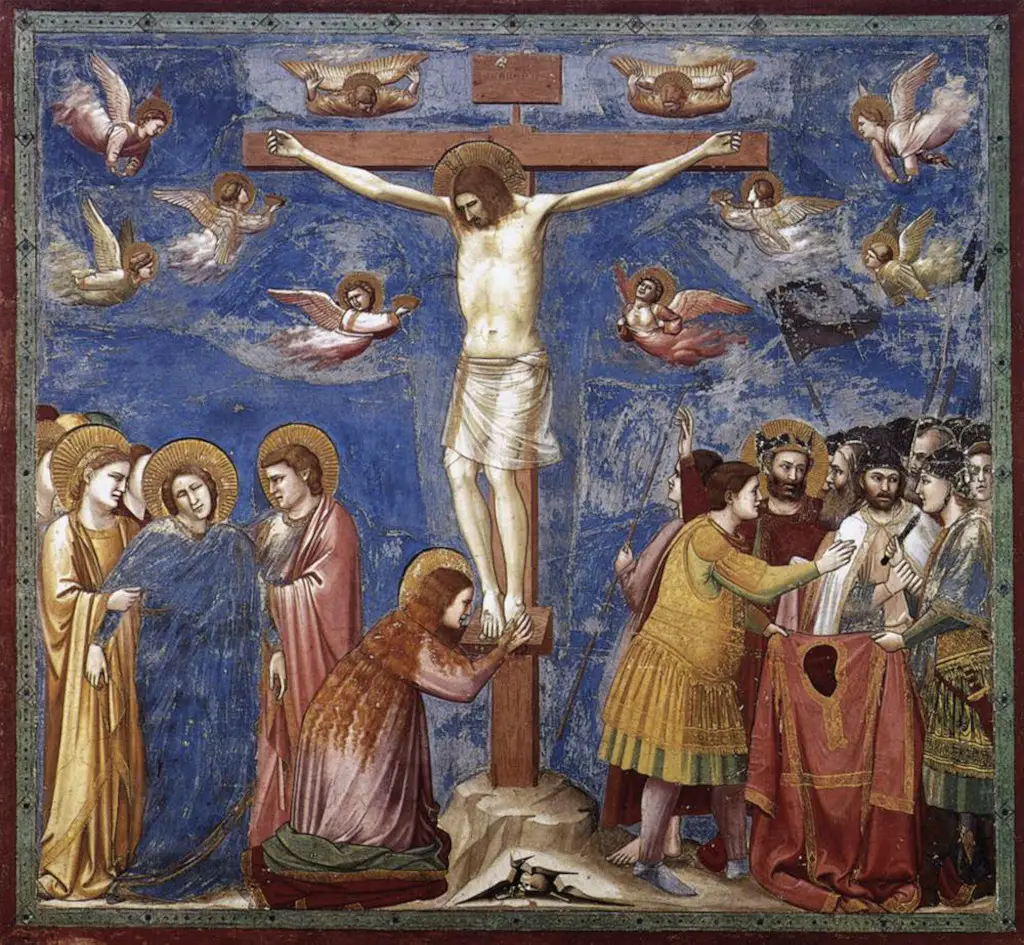
More Renaissance Artists



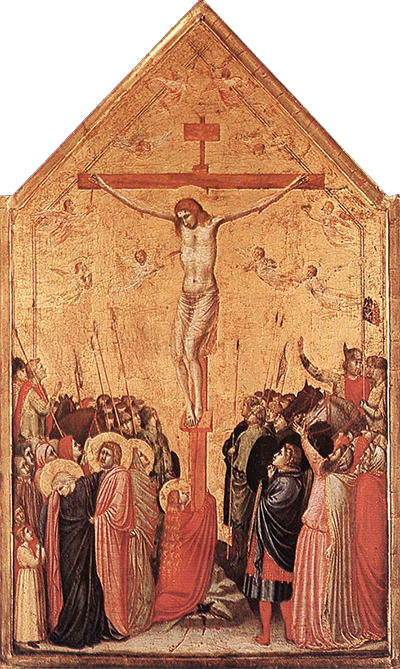


 Giotto.jpg)
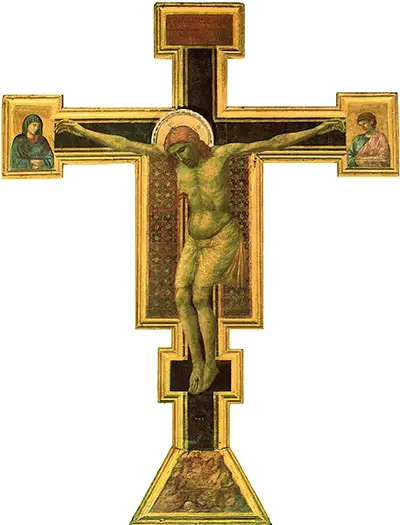
 Giotto.jpg)
 Giotto.jpg)
